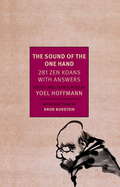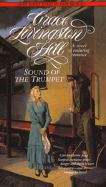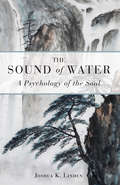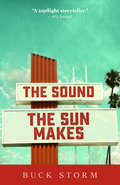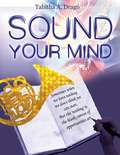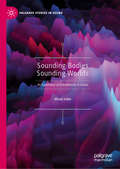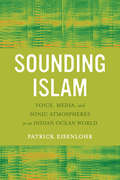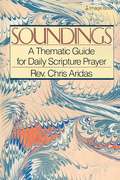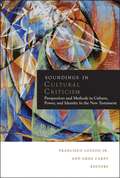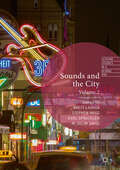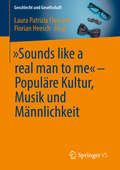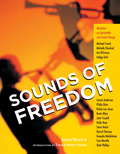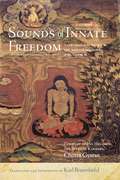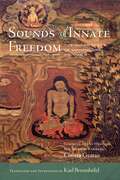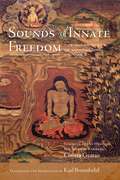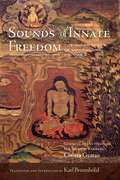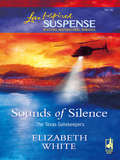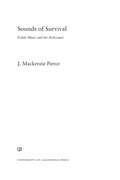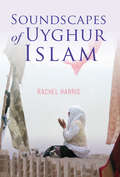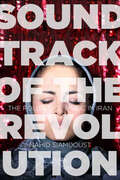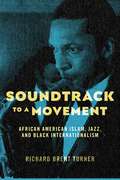- Table View
- List View
The Sound of Sleigh Bells: A Romance from the Heart of Amish Country (Apple Ridge)
by Cindy WoodsmallBeth Hertzler works alongside her beloved Aunt Lizzy in their dry goods store, and serving as contact of sorts between Amish craftsmen and Englischers who want to sell the Plain people's wares. But remorse and loneliness still echo in her heart everyday as she still wears the dark garb, indicating mourning of her fiancé. When she discovers a large, intricately carved scene of Amish children playing in the snow, something deep inside Beth's soul responds and she wants to help the unknown artist find homes for his work-including Lizzy's dry goods store. But she doesn't know if her bishop will approve of the gorgeous carving or deem it idolatry. Lizzy sees the changes in her niece when Beth shows her the woodworking, and after Lizzy hunts down Jonah, the artist, she is all the more determined that Beth meets this man with the hands that create healing art. But it's not that simple-will Lizzy's elaborate plan to reintroduce her niece to love work? Will Jonah be able to offer Beth the sleigh ride she's always dreamed of and a second chance at real love-or just more heartbreak?From the Hardcover edition.
The Sound of the One Hand: 281 Zen Koans with Answers
by Dror Burstein Yoel Hoffman Yoel HoffmannWhen The Sound of the One Hand came out in Japan in 1916 it caused a scandal. Zen was a secretive practice, its wisdom relayed from master to novice in strictest privacy. That a handbook existed recording not only the riddling koans that are central to Zen teaching but also detailing the answers to them seemed to mark Zen as rote, not revelatory.For all that, The Sound of the One Hand opens the door to Zen like no other book. Including koans that go back to the master who first brought the koan teaching method from China to Japan in the eighteenth century, this book offers, in the words of the translator, editor, and Zen initiate Yoel Hoffmann, "the clearest, most detailed, and most correct picture of Zen" that can be found. What we have here is an extraordinary introduction to Zen thought as lived thought, a treasury of problems, paradoxes, and performance that will appeal to artists, writers, and philosophers as well as Buddhists and students of religion.
Sound of the Trumpet (Grace Livingston Hill #90)
by Grace Livingston HillThe first time beautiful, wealthy Lisle Kingsley sees John Sargent, she knows she loves him. But John is all too aware of the differences in their social standings. Besides, Lisle is practically engaged to wealthy Victor Vandingham, whose father is in charge of manufacturing a top secret weapon that supposedly will bring the war to a rapid and decisive end. Then John is approached by men who are scheming to steal the weapon and its blueprints.... men who know of John's growing friendship with Lisle.... men who will stop at nothing--even kidnapping Lisle--to get John to cooperate with them!
The Sound of Water
by Joshua K. LindenAfter a lifetime of living, Joshua K. Linden heard the sound of water in a whole new way. The mesmerizing, meditative sound resonated so deeply within his soul that it propelled him on a seven year journey of reflection: on soul, ego, and our place within the web of life. What he has discovered during his journey is suffering is a result of the battle between the ego and the Soul. The ego wants to plan and create a future whereas the Soul needs to express itself in the present. If one is truthful, eventually one awakens to the fact that the body will die, and that the future in this dimension is limited. The Sound of Water leads readers to understand it is in their best interest to shed the ego and to live life with the Soul that is eternal. Linden's book points you in the direction of this Source. This is where your essence and the essence of all things flow into one another--without deception, distortion, or corruption. Beautifully designed, The Sound of Water offers a series of thoughts and meditations that will guide you in your own journey to reconnect with the Source. You are invited to read it from beginning to end, or flip to a page at random to find deep insight and wisdom; inspiring you to awaken to living a life that deeply honors and values the Soul.
The Sound the Sun Makes (Ballads of Paradise #2)
by Buck StormLiterary Americana with humor, heart, and a whole lot of twists to keep readers guessingDetective Early Pines loves his southern Arizona desert, often thinking he could stare at it all day long. But now that he's forced to do just that, the truth is the view from his back porch is getting old. He's on mandatory leave from the police department, simply for punching a wife beater who had it coming. Early is in dire need of a distraction from his own loud thoughts. So when an old friend invites him to tag along to a rodeo down in Old Mex, it seems like just the ticket.But if there's one constant in the world, it's that life always throws a guy curveballs. With a flat tire, a roadside bar, and a beautiful woman with trouble on her hands, Early's distraction takes a hard right turn--straight to Los Angeles, six hundred miles west.Hammott Lamont is waiting there in his own personal hunting ground. The reclusive filmmaker is a veritable cult leader to Hollywood stars--and he's sure his latest project will redefine art history in his image. He's got a plan for a brutal, modernized version of the Christ story, and he's ready to trample anyone who stands in the way of his colossal vision. That is, until big, loud Early Pines hits the coast for a clash of two titans who never saw each other coming.Quirky, lyrical, and unexpected, The Sound the Sun Makes offers a warm and sunny side trip for fans of Jimmy Buffett, Carl Hiaasen, and Barbara Kingsolver who long for more of a Christian worldview in their fiction.
Sound the Trumpet (Liberty Bell, #1)
by Gilbert MorrisBook 1, Liberty Bell series; Christian fiction
Sound Your Mind
by D. Ivan Ursey II Jdamian Brown Tabitha A. DragoLife experiences expressed through inspirational poetry.
Sounding Bodies Sounding Worlds: An Exploration of Embodiments in Sound (Palgrave Studies in Sound)
by Mickey ValleeWhat makes a body of sound appear as an aesthetic object as well as a method for knowledge? In Sounding Bodies Sounding Worlds, Mickey Vallee argues that we must impose our sonic imagination onto the non-sonic, and embrace how we sound to ourselves, sound with our animal companions, and sound in very earth itself. From the invention of the laryngoscope to the role of the spectrogram, from the call of the bird to the tumble of a rockslide, from the deep listening of environmental immersion to the computational listening of bioacoustics research, Vallee offers a wide range of cases to convincingly argue that all life shares in a continuous, embodied and ethical vibration.
Sounding Islam: Voice, Media, and Sonic Atmospheres in an Indian Ocean World
by Patrick EisenlohrA free ebook version of this title is available through Luminos, University of California Press’s Open Access publishing program. Visit www.luminosoa.org to learn more.Sounding Islam provides a provocative account of the sonic dimensions of religion, combining perspectives from the anthropology of media and sound studies, as well as drawing on neo-phenomenological approaches to atmospheres. Using long-term ethnographic research on devotional Islam in Mauritius, Patrick Eisenlohr explores how the voice, as a site of divine manifestation, becomes refracted in media practices that have become integral parts of religious traditions. At the core of Eisenlohr’s concern is the interplay of voice, media, affect, and listeners’ religious experiences. Sounding Islam sheds new light on a key dimension of religion, the sonic incitement of sensations that are often difficult to translate into language.
The Sounding Joy, Love's Pure Light (CHRISTMAS MIRACLES of MARBLE COVE #2)
by Sunni Jeffers Camy TangIn The Sounding Joy, finding the sets for the living Nativity feels like an insurmountable challenge for Margaret, whose already fragile Christmas spirit is dampened by the discovery that her Down syndrome daughter won’t be home for the holiday. The inexplicable arrival of a child’s Popsicle stick decoration on her doorstep brings an unforgettable encounter with a young man seeking answers in Marble Cove--and renewed joy for Margaret when she discovers the miraculous story behind the homemade ornament. In Love’s Pure Light, when Beverly discovers a battered old wreath washed up on the beach, it seems strangely familiar to her. What is that snippet of song it evokes each time she looks at it? As she and her friends work together to overcome the last challenges to reviving the living Nativity, can she trace her memories of the haunting melody to uncover the secrets of the wreath and shine the light of love on long-buried family hurts? It’s Christmastime in Marble Cove, Maine, and miracles abound for four dear friends and neighbors in this charming seaside village. When Diane Spencer, Shelley Bauer, Margaret Hoskins, and Beverly Mackenzie each receive a mysterious Christmas gift, it sets them on journeys of discovery as the holiday approaches. And when they set out to resurrect a forgotten town tradition, there’s no telling what might happen!
Soundings: A Thematic Guide for Daily Scripture Prayer
by Chris AridasA thematic guide for daily scripture prayer.
Soundings in Cultural Criticism: Perspectives and Methods in Culture, Power, and Identity in the New Testament
by Francisco Lozada Jr. Greg CareyA number of disciplines aligned under "cultural criticism" have changed the shape of contemporary biblical studies not only by offering new methods but by questioning old goals and proposing new ones. Soundings in Cultural Criticism offers a collection of succinct essays in these fields by some of the foremost scholars in New Testament studies.
Sounds and the City: Volume 2 (Leisure Studies in a Global Era)
by Stephen Wagg Karl Spracklen Brett Lashua M. Selim YavuzThis book draws from a rich history of scholarship about the relations between music and cities, and the global flows between music and urban experience. The contributions in this collection comment on the global city as a nexus of moving people, changing places, and shifting social relations, asking what popular music can tell us about cities, and vice versa. Since the publication of the first Sounds and the City volume, various movements, changes and shifts have amplified debates about globalization. From the waves of people migrating to Europe from the Syrian civil war and other conflict zones, to the 2016 “Brexit” vote to leave the European Union and American presidential election of Donald Trump. These, and other events, appear to have exposed an anti-globalist retreat toward isolationism and a backlash against multiculturalism that has been termed “post-globalization.” Amidst this, what of popular music? Does music offer renewed spaces and avenues for public protest, for collective action and resistance? What can the diverse histories, hybridities, and legacies of popular music tell us about the ever-changing relations of people and cities?
„Sounds like a real man to me“ – Populäre Kultur, Musik und Männlichkeit (Geschlecht und Gesellschaft #69)
by Laura Patrizia Fleischer Florian HeeschIn populärer Kultur ist Männlichkeit ein vielschichtiges Thema – hörbar und sichtbar in Sounds, Performances, Medien, Moden, Biographien, Szenen und (Selbst-)Inszenierungen. Was ist Männlichkeit? Zu dieser nicht (mehr) eindeutig zu beantwortenden Frage liefern populäre Musiken, Medien und Szenen diverse Aussagen und Darstellungen, mal eher traditionell, mal eher transgressiv, wobei sich durch Hautfarbe, sexuelle Orientierung, Herkunft oder Behinderung jeweils Bedeutungsverschiebungen ergeben. Anhand vielfältiger populärkultureller Phänomene bietet der Sammelband facettenreiche Einblicke in die aktuelle Männlichkeitsforschung der Geistes-, Kultur- und Sozialwissenschaften.
Sounds Like Skipper: The Story of Kerena Marchant and Her Hearing Dog Skipper
by Kerena Marchant<P>Skipper is a shaggy-haired Jack Russell, one of the earliest dogs trained in a new scheme to help people suffering from deafness. The author, a permanent researcher for BBC TV, has been deaf since infancy. Modern technology can equip her with a special high-powered hearing aid, but Skipper enables her to live alone, summoning her to doorbells and telephones, waking her when the alarm rings, and warning her of such unexpected hazards as burglars or fire alarms. The author's story of life with Skipper is full of insights into the plight of the deaf in contemporary society. <P>Kerena tells her story of how she received Skipper a Jack Russell terror mix dog, and how his presence changed her life. She also discusses some problems that she experienced as a almost deaf person in a hearing world, and her experiences with the deaf community too.
Sounds of Freedom
by John Malkin Thich Nhat HanhIn Sounds of Freedom, sixteen extraordinary musicians share their intimate thoughts on art, spirituality, and social change. These intimate interviews offer a rare glimpse into the personal motivations of these public artists.Includes interviews with: Michael Franti, Michelle Shocked, Ani DiFranco, Indigo Girls, Laurie Anderson, Philip Glass, Rickie Lee Jones, Boots Riley, John Trudell, Holly Near, Steve Reich, Darryl Cherney, Goapele Mohlabane, Tom Morello, Utah Philips.
Sounds of Innate Freedom: The Indian Texts of Mahamudra, Vol. 5
by Karl BrunnhölzlThe first volume in an historic and noteworthy 6-volume series containing many of the first English translations of the classic mahamudra literature compiled by the Seventh Karmapa.Sounds of Innate Freedom: The Indian Texts of Mahamudra is an historic six-volume series containing many of the first English translations of classic Mahamudra literature. The texts and songs in these volumes constitute the large compendium called The Indian Texts of the Mahamudra of Definitive Meaning, compiled by the Seventh Karmapa, Chötra Gyatso (1456–1539). Mahamudra refers to perfect buddhahood in a single instant, the omnipresent essence of mind, nondual and free of obscuration. This collection offers a brilliant window into the richness of the vast ocean of Indian Mahamudra texts, many cherished in all Tibetan lineages, particularly in the Kagyü tradition, giving us a clear view of the sources of one of the world&’s great contemplative traditions. This first volume in publication contains the majority of songs of realization, consisting of dohas (couplets), vajragitis (vajra songs), and caryagitis (conduct songs), all lucidly expressing the inexpressible. These songs offer readers a feast of profound and powerful pith instructions uttered by numerous male and female mahasiddhas, yogis, and dakinis, often in the context of ritual ganacakras and initially kept in their secret treasury. Displaying a vast range of themes, styles, and metaphors , they all point to the single true nature of the mind—mahamudra—in inspiring ways and from different angles, using a dazzling array of skillful means to penetrate the sole vital point of buddhahood being found nowhere but within our own mind. The beautifully translated texts brilliantly capture the wordplay, mystical wonder, bliss, and ecstatic sense of freedom expressed by awakened Mahamudra masters of India. It includes works by Saraha, Mitrayogi, Virupa, Tilopa, Naropa, Maitripa, Nagarjuna, the female mahasiddhas princess Laksmimkara and Dombiyogini, and otherwise unknown awakened figures of this rich tradition. Reading and singing these songs that convey the inconceivable and contemplating their meaning in meditation will open doors to spiritual experience for us today just as it has for countless practitioners in the past.
Sounds of Innate Freedom: The Indian Texts of Mahamudra, Volume 4
by Karl BrunnhölzlThe second volume in an historic and noteworthy 6-volume series containing many of the first English translations of the classic mahamudra literature compiled by the Seventh Karmapa as well as extensive commentary that brilliantly unravels enigmas and clarifies cryptic verses.Sounds of Innate Freedom: The Indian Texts of Mahamudra are historic volumes containing many of the first English translations of classic mahamudra literature. The texts and songs in these volumes constitute the large compendium called The Indian Texts of the Mahamudra of Definitive Meaning, compiled by the Seventh Karmapa, Chötra Gyatso (1456–1539). The collection offers a brilliant window into the richness of the vast ocean of Indian mahamudra texts cherished in all Tibetan lineages, particularly in the Kagyü tradition, giving us a clear view of the sources of one of the world&’s great contemplative traditions. Besides the individual dohas (couplets), vajragitis (vajra songs), and caryagitis (conduct songs) in this second volume in publication, the three extensive commentaries it contains brilliantly unravel enigmas and bring clarity not only to the specific songs they comment on but to many other, often cryptic, songs of realization in this collection. These expressive songs of the inexpressible offer readers a feast of profound and powerful pith instructions uttered by numerous male and female mahasiddhas, yogis, and dakinis, often in the context of ritual ganacakras and initially kept in their secret treasury. Displaying a vast range of themes, styles, and metaphors, they all point to the single true nature of the mind—mahamudra—in inspiring ways and from different angles, using a dazzling array of skillful means to penetrate the sole vital point of buddhahood being found nowhere but within our own mind. Reading and singing these songs of mystical wonder, bliss, and ecstatic freedom, and contemplating their meaning, will open doors to spiritual experience for us today just as it has for countless practitioners in the past.
Sounds of Innate Freedom: The Indian Texts of Mahamudra, Volume 3
by Karl BrunnhölzlThe third volume in a historic six-volume series containing many of the first English translations of the classic mahamudra literature compiled by the Seventh Karmapa.Sounds of Innate Freedom: The Indian Texts of Mahamudra are historic volumes containing many of the first English translations of the classic mahamudra literature. The texts and songs in these volumes constitute the large compendium called The Indian Texts of the Mahamudra of Definitive Meaning, compiled by the Seventh Karmapa Chötra Gyatso (1456–1539). Translated, introduced, and annotated by Karl Brunnhölzl, acclaimed senior teacher at the Nalandabodhi community of Dzogchen Ponlop Rinpoche, the collection offers a brilliant window into the richness of the vast ocean of Indian mahamudra texts cherished in all Tibetan lineages, particularly in the Kagyu tradition, giving us a clear view of the sources of one of the world&’s great contemplative traditions. This third volume contains twenty-four texts, the bulk of which are dohas by Saraha and commentaries on them, as well as works by other renowned Indian Buddhist mahasiddhas such as Naropa, Krsna, and Sakyasribhadra. The extensive commentaries brilliantly unravel enigmas and bring clarity to the songs they comment on as well as to many other songs of realization in the series. These expressive songs of the inexpressible offer readers a feast of profound and powerful pith instructions uttered by numerous male and female mahasiddhas, yogis, and dakinis, often in the context of ritual ganacakras and initially kept in their secret treasury. Displaying a vast range of themes, styles, and metaphors, they all point to the single true nature of the mind—mahamudra—in inspiring ways and from different angles, using a dazzling array of skillful means to penetrate the sole vital point of buddhahood being found nowhere but within our own mind. Reading and singing these songs of mystical wonder, bliss, and ecstatic freedom and contemplating their meaning will open doors to spiritual experience for us today just as it has for countless practitioners in the past.
Sounds of Innate Freedom: The Indian Texts of Mahamudra, Volume 2 (Sounds of Innate Freedom #2)
by Karl BrunnhölzlThe second volume in a historic six-volume series containing many of the first English translations of the classic Mahamudra literature compiled by the Seventh Karmapa.Sounds of Innate Freedom: The Indian Texts of Mahamudra are historic volumes containing many of the first English translations of the classic Mahamudra literature. The texts and songs in these volumes constitute the large compendium called The Indian Texts of the Mahamudra of Definitive Meaning, compiled by the Seventh Karmapa Chötra Gyatso (1456–1539). Translated, introduced, and annotated by Karl Brunnhölzl, acclaimed senior teacher at the Nalandabodhi community of Dzogchen Ponlop Rinpoche, the collection offers a brilliant window into the richness of the vast ocean of Indian Mahamudra texts cherished in all Tibetan lineages, particularly in the Kagyü tradition, giving us a clear view of the sources of one of the world&’s great contemplative traditions. This volume 2 (thirty-four texts) contains two long-established sets of Mahamudra works: &“The Sixfold Pith Cycle&” and short texts of Maitripa&’s &“Twenty-Five Dharmas of Mental Nonengagement,&” which present a blend of Madhyamaka, Mahamudra, and certain tantric principles, as well as two commentaries by Maitripa&’s students. The vital focus of this volume is the accomplishment of true reality.
Sounds of Silence
by Elizabeth WhiteBorder Patrol agent Eli Carmichael knew the deaf child he'd found outside a Mexican orphanage was harboring a dark secret--she was carrying a bloodstained knife and was clearly traumatized. To keep her safe, he turned to trusted neighbor Isabel Valenzuela. A sense of duty had kept Eli close to his fellow agent's widow and her young son over the past year, and now Eli was spending more time with Isabel and the kids, trying to determine exactly what the girl had seen. Under Isabel's gentle care, the child began to open up. But the killers were close by, and determined to silence the girl forever. . . .
Sounds of Survival: Polish Music and the Holocaust
by J. Mackenzie PierceSounds of Survival tells a story of unexpected musical continuity across some of the twentieth century's most cataclysmic events. It examines an integrated Polish and Polish Jewish musical community as its members contended with antisemitism in the 1930s, attempted to survive the Nazi occupation, and established a renewed musical culture amid the ashes of World War II and the Holocaust. Reconstructing these musicians' lives from the 1920s into the 1950s, J. Mackenzie Pierce argues that despite nearly unimaginable violence, many Polish musicians treated the war as a time of reinvention and cultural preservation. Their faith that music was a source of cultural continuity, however, also marginalized experiences of wartime loss, especially those of Jewish victims and survivors of the Holocaust. Sounds of Survival not only reveals that the Holocaust was a central event within modern Polish musical culture; it also shows why its musical aftermath has been difficult to hear.
Soundscapes of Uyghur Islam (Framing the Global)
by Rachel HarrisChina's Xinjiang Uyghur Autonomous Region is experiencing a crisis of securitization and mass incarceration. In Soundscapes of Uyghur Islam, author Rachel Harris examines the religious practice of a group of Uyghur women in a small village now engulfed in this chaos. Despite their remote location, these village women are mobile and connected, and their religious soundscapes flow out across transnational networks. Harris explores the spiritual and political geographies they inhabit, moving outward from the village to trace connections with Mecca, Istanbul, Bishkek, and Beijing. Sound, embodiment, and territoriality illuminate both the patterns of religious change among Uyghurs and the policies of cultural erasure used by the Chinese state to reassert its control over the land the Uyghurs occupy. By drawing on contemporary approaches to the circulation of popular music, Harris considers how various forms of Islam that arrive via travel and the Internet come into dialogue with local embodied practices. Synthesized together, these practices create new forms that facilitate powerful, affective experiences of faith.
Soundtrack of the Revolution: The Politics of Music in Iran
by Nahid SiamdoustMusic was one of the first casualties of the Iranian Revolution. It was banned in 1979, but it quickly crept back into Iranian culture and politics. The state made use of music for its propaganda during the Iran–Iraq war. Over time music provided an important political space where artists and audiences could engage in social and political debate. Now, more than thirty-five years on, both the children of the revolution and their music have come of age. Soundtrack of the Revolution offers a striking account of Iranian culture, politics, and social change to provide an alternative history of the Islamic Republic. Drawing on over five years of research in Iran, including during the 2009 protests, Nahid Siamdoust introduces a full cast of characters, from musicians and audience members to state officials, and takes readers into concert halls and underground performances, as well as the state licensing and censorship offices. She closely follows the work of four musicians—a giant of Persian classical music, a government-supported pop star, a rebel rock-and-roller, and an underground rapper—each with markedly different political views and relations with the Iranian government. Taken together, these examinations of musicians and their music shed light on issues at the heart of debates in Iran—about its future and identity, changing notions of religious belief, and the quest for political freedom. Siamdoust shows that even as state authorities resolve, for now, to allow greater freedoms to Iran's majority young population, they retain control and can punish those who stray too far. But music will continue to offer an opening for debate and defiance. As the 2009 Green Uprising and the 1979 Revolution before it have proven, the invocation of a potent melody or musical verse can unite strangers into a powerful public.
Soundtrack to a Movement: African American Islam, Jazz, and Black Internationalism
by Richard Brent Turner**FINALIST for the 2022 PROSE Award in Music & the Performing Arts****Certificate of Merit, Best Historical Research on Recorded Jazz, given by the 2022 Association for Recorded Sounds Collection Awards for Excellence in Historical Sound Research** Explores how jazz helped propel the rise of African American Islam during the era of global Black liberation Amid the social change and liberation of the civil rights and Black Power movements, the tenor saxophonist Archie Shepp recorded a tribute to Malcolm X’s emancipatory political consciousness. Shepp saw similarities between his revolutionary hero and John Coltrane, one of the most influential jazz musicians of the era. Later, the esteemed trumpeter Miles Davis echoed Shepp’s sentiment, recognizing that Coltrane’s music represented the very passion, rage, rebellion, and love that Malcolm X preached. Soundtrack to a Movement examines the link between the revolutionary Black Islam of the post-WWII generation and jazz music. It argues that from the late 1940s and ’50s though the 1970s, Islam rose in prominence among African Americans in part because of the embrace of the religion among jazz musicians. The book demonstrates that the values that Islam and jazz shared—Black affirmation, freedom, and self-determination—were key to the growth of African American Islamic communities, and that it was jazz musicians who led the way in shaping encounters with Islam as they developed a Black Atlantic “cool” that shaped both Black religion and jazz styles. Soundtrack to a Movement demonstrates how by expressing their values through the rejection of systemic racism, the construction of Black notions of masculinity and femininity, and the development of an African American religious internationalism, both jazz musicians and Black Muslims engaged with a global Black consciousness and interconnected resistance movements in the African diaspora and Africa.

